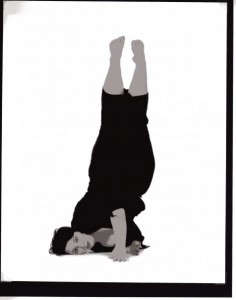by Kimberly Peterson
There is a quality in movement that I love to see and makes me engage with material in a completely different way than other dance. It’s hard to describe, but I know it when I see it. In fact, I find most people have a certain stylistic choice or a certain way of moving that feels good to them, or that is interesting to watch or work within.
This clip instantly captured me. I realized that it sort of encapsulated the continuous motion that intrigues me as a choreographer, stimulates me as a dancer and captivates me as an audience member. It is the union of opposites that intrigues me – lightness and weight, controlled and yet abandoned, strength and yet ease…the complexity and texture this creates in performance is breathtaking to me and yet is not accidental.
Watching this class I find myself drawn to the fluidity of the movement, the way it pauses – but never really stops; the ability to create interest through utilizing the floor and all surfaces of the body; the mercurial quality as bodies pour from one place to the next.
But it’s not just visually enchanting – it’s also incredibly stimulating mentally. This particular technique lends itself well to individual choice making and gives the dancers freedom in choosing how to find their way out of “mistakes”. In fact, this may even eliminate the idea of “mistakes” in favor of dancers’ own timing.
There is a beautiful example of this at about 1:21. The man in the white pants finds himself on another step but is able to catch back up with some strategic choices. While not as seamless as it perhaps would be, were he more familiar with the material, it exemplifies the many ways in which one can arrive at a particular shape, from another particular shape.
In fact, I would go so far as to say that techniques such as this, allow for dancers to connect more freely with the movements they perform – allowing for them to become aware of the time it takes to reach the edges of the movement – rather than creating shapes on specific counts. It is a difficult education, but one that separates rote memory from artistry.
An example of how different this looks can be found at 1:39. Look at the difference in movement quality from the gentleman in the striped shirt and the women in the blue shirt and cropped pants on the right. It’s not that anything she does is incorrect; she makes all the same shapes and gets to the same end place. But it’s how she gets there – never releasing her head, the act of preparation for inversions rather than pouring into the floor, the “placed” arms as opposed to reaching – that really separates the movement from the body.
There is a great sense of freedom that evolves out of dancers really understanding internally, kinesthetically, what movement “is” in their bodies. It allows simple phrases to develop into choreographic structures (3:53) as those who “hear” the movement the same way synchronize and make similar choices. It allows one to see the full breadth of a single movement (2:09) through different bodies making different kinesthetic choices. Further it respects those choices, and in some ways needs those choices, in order to be the dynamic force that captivates us.
For me, the best movement, the most captivating performances, are always those that are first physically stimulating to me – movement that feels good to do. And secondly, movement that intrigues me while experiencing it. I don’t like to be able to figure it all out. I like movement that you have to “unpack” a little to get at the nuance and discover the subtlety. I like movement that makes me think a little harder, work a little harder to get at what makes it tick.
I encourage dance educators to push their students to make conscious choices and to explore techniques which encourage kinesthetic education. I also encourage students to take those risks and create complexity by observing with more than your eyes.

BIO: Contributor Kimberly Peterson, a transplant to Minneapolis from the Dallas area, received her BA and MA from Texas Woman’s University’s prestigious dance program.
Drawing on her experience with producing dance works, Kimberly has served as lighting designer, stage manager, event coordinator, volunteer and an advisor in various roles. She has taught in various roles and her choreography featured at ACDFA, TCC South Campus and Zenon Dance Studios. Her recent internships with Theater Space Project and the Minnesota Children’s Museum have served to expand her skills in arts administration and development.
Her graduate research explored the parallels between the independent music industry and current methods of dancer representation. Fascinated with how art is represented and presented in society, she continues to develop this research while delving further into this complicated subject through her dance writing.




